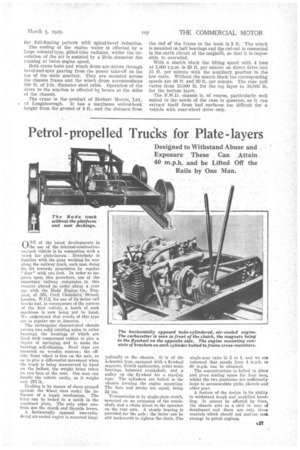A Heavy-duty
Page 48

Page 49

If you've noticed an error in this article please click here to report it so we can fix it.
MOBILE CRANE
ANinteresting form of mobile crane is that which we illustrate, and although this particular model is designed for a specific task, there is no reason why it should not be modified to meet many requirements.
The first appliance of this type was built a few months ago for a well-known oil company by the Four Wheel Drive Lorry Co., Ltd., of 46, Charing Cross, London, S.W.1. It is a standard 6-ton F.W.D. model, equipped with 46-in. by 8-in. giant pneumatic tyres, those at the rear being twins; furthermore, it is provided with two standard F.W.D. winches, one being utilized for slewing and the other for operating the crane hook.
The machine is employed in the oil fields at points where drilling for the crude. is taking place, which is generally in a hollow. When the prospecting work is finished the plant has to be shifted to another site, and with this mobile crane the machinery. is pulled up the slope, using the rear wineh, until it can be picked up with the crane, which has a lifting capacity of 4 tons. The machinery is held in this manner while. the vehicle goes forward, so that the load can be placed. on to a lorry or taken direct to the next scene of operations........
We are told that the saving of cost in a Week
• with such 'work, as compared with what it would have been if Coolies had been em
. ployed, is £58, .sothat, if kept constantly di -work, such a vehicle should _very quickly repay the caPital. expenditure.
Attention to detail is shown by the fact that swivelling headlights are fitted, so that these may be turned around to throw their beams to the rear of the machine, whilst an additional searchlight is mounted on the roof of the cab. Incidentally, . this cab is built entirely of teak, because the vehicle has to operate under tropical conditions.
The engine has four cylinders of 5; ins. bore and 51 ins. stroke. A clutch of the Hele Shaw multiple-disc_ type running in oil carries the drive to a constant-mesh auxiliary gearbox fitted between the clutch and the gearbox; this adjunct gives direct drive and a reduction of 2.23 to 1 on all main-gearbox ratios. The beveltype centre differential is equipped with dog clutches operated from the side of the.. chassis, by means of which it ,.can be . locked. Propeller . shafts with Hardy. Spicer universal ,joints take the drive to the front and rear axles, which are of
the full-floating pattern with spiral-bevel reduction.
The cooling of the engine water is effected by a large colonial-type, gilled-tube radiator, whilst the circulation of the air is assisted by a 20-in.-diameter fan running at twice engine speed.
Both crane hoist and winch drum are driven through bevel-and-spur gearing from the power take-off on the top of the main gearbox. They are mounted across the chassis frame and the winch drum accommodates 300 ft. of Fin, diameter steel cable. Operation of the drive to the winches is effected by levers at the sides of the chassis.
The crane is the' product of Herbert Morris, Ltd., • of Loughborough. It has a maximum swivel-hook height from the ground of 9 ft., and the distance from
the end of the frame to the hook is 3 ft. The winch is mounted on ball bearings and the cut-out is connected in the earth circuit of the mtignero, so that it is impossible to overwind.
With a snatch block the lifting speed with 4 tons at 1,000 r.p.m. is 33 ft. per minute on direct drive and 15 ft. per minute with the auxiliary gearbox in the low ratio. Without the snatch block the corresponding speeds are 66 ft. and 30 ft. per minute. The rope pull varies from 10,000 lb. for the top layer to 16,000 lb. for the bottom layer.
The F.W.D. chassis is, of course, particularly well suited to the needs of the case in question, as it can extract itself from bad surfaces too difficult for a vehicle with rear-wheel drive only.












































































































